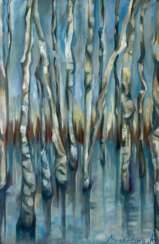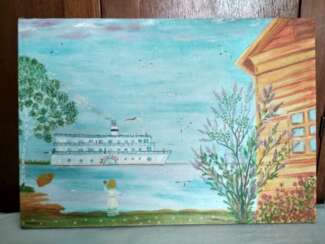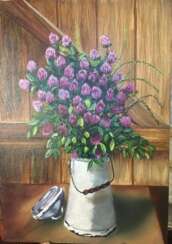435 Items by auctions and galleries:
paint brush
Parrot painting Bird art
Ludmila Riabkova (b. 1973)  Shop Riabkova Ludmila
Shop Riabkova Ludmila

Ludmila Riabkova
14.02.1973
Ukraine
I`m Lyudmila Ryabkova. I was born in 1973 in Kiev, Ukraine.
I graduated technical college and got second higher economic education. I studied at the privat art studio of Ukrainian professional artist. My works find feedback from people, they are bought, it inspires me very much. My workshop is equipped right in my house and it makes possible to work every day. This is the most beautiful thing that happens to me.

Artist shop
Riabkova Ludmila
Ukraine
Number of products: 27
Unique pet portrait Puppy portrait Pet portrait canvas Puppy painting Dog artwork Сute dog
Ludmila Riabkova (b. 1973)  Shop Riabkova Ludmila
Shop Riabkova Ludmila

Ludmila Riabkova
14.02.1973
Ukraine
I`m Lyudmila Ryabkova. I was born in 1973 in Kiev, Ukraine.
I graduated technical college and got second higher economic education. I studied at the privat art studio of Ukrainian professional artist. My works find feedback from people, they are bought, it inspires me very much. My workshop is equipped right in my house and it makes possible to work every day. This is the most beautiful thing that happens to me.

Artist shop
Riabkova Ludmila
Ukraine
Number of products: 27
Parrots. Oil painting for home or office
Ekaterina Zhuchenko RedHeadKat (b. 1979)  Shop Zhuchenko RedHeadKat Ekaterina
Shop Zhuchenko RedHeadKat Ekaterina

Ekaterina Zhuchenko RedHeadKat
12.08.1979
Byelorussia
EN/RU
.
My name is Ekaterina Zhuchenko, creative pseudonym RedHeadKat.
I have been an artist from an early age. Dad's sketchbook was the greatest treasure. Then I had not dreamed of writing yet
oil. A large set of watercolors in a white plastic box was often secretly taken from the shelf for my
naive art. The thick squirrel brush gave an unforgettable tactile sensation.
But I was able to forget about it "becoming an adult".
I am grateful to the people who helped me return everything. At some point, I realized that I couldn’t stop it. The same set of watercolors, already replenished with new shades. It
became my frequent joy. And oil painting is my discovery and a way to restore connection with my family and father.
.
1996-1999: Minsk Technological College. Fashion designer with a course in painting and acaemic drawing, in-depth study of fashion illustration
2020 to the present day: studying painting in the Graphics studio, Minsk
2021 course of painting with a palette knife at the St. Petersburg School of Oil Painting
Меня зовут Жученко Екатерина, творческий псевдоним RedHeadKat
Я была художником с малых лет. Папин этюдник был самой большой сокровищницей, хоть я тогда и не мечтала писать маслом. Большой набор акварельных красок в белой пласт-
ковой коробке часто в тайне был взят с полки для моего наивного детского искусства, а толстая кисть-белка дарила незабываемые тактильные ощущения.
Но я смогла забыть об этом "став взрослой".
Я благодарна людям, которые помогли мне всё вернуть. В какой-то момент я поняла, что не писть я уже не смогу. Тот самый набор акварели, уже пополненный новыми оттенками, стал моей частой радостью. А живопись маслом — моим способом восстановления связи с родом и отцом.
.
.
.

Artist shop
Zhuchenko RedHeadKat Ekaterina
Byelorussia
Number of products: 21
Cubism Pears painting Knife texture Fruits Paintings Cubism art Still life
Ludmila Riabkova (b. 1973)  Shop Riabkova Ludmila
Shop Riabkova Ludmila

Ludmila Riabkova
14.02.1973
Ukraine
I`m Lyudmila Ryabkova. I was born in 1973 in Kiev, Ukraine.
I graduated technical college and got second higher economic education. I studied at the privat art studio of Ukrainian professional artist. My works find feedback from people, they are bought, it inspires me very much. My workshop is equipped right in my house and it makes possible to work every day. This is the most beautiful thing that happens to me.

Artist shop
Riabkova Ludmila
Ukraine
Number of products: 27
Helga Grosman (b. 1994)  Shop Grosman Helga
Shop Grosman Helga

Helga Grosman
18.08.1994
Russia
Hey! My name is Olga Grosman, but I use the pseudonym Helga Benefit in my work. I am not a professional artist, but my paintings are in private collections in Russia and the world (I don't even know where they were taken). Dreaming of my own exhibition, preparing an interesting series of paintings. I will be glad to share my creativity and a piece of myself with you.
All my works are exclusive, have no analogs and repetitions

Artist shop
Grosman Helga
Russia
Number of products: 4
Helga Grosman (b. 1994)  Shop Grosman Helga
Shop Grosman Helga

Helga Grosman
18.08.1994
Russia
Hey! My name is Olga Grosman, but I use the pseudonym Helga Benefit in my work. I am not a professional artist, but my paintings are in private collections in Russia and the world (I don't even know where they were taken). Dreaming of my own exhibition, preparing an interesting series of paintings. I will be glad to share my creativity and a piece of myself with you.
All my works are exclusive, have no analogs and repetitions

Artist shop
Grosman Helga
Russia
Number of products: 4
Red face
Elizaveta RAT (b. 2002) 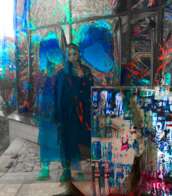 Shop RAT Elizaveta
Shop RAT Elizaveta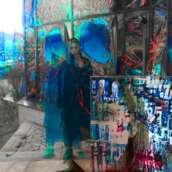

Elizaveta RAT
16.10.2002
Russia
Hello! I am a young artist from St. Petersburg
My creativity is, first of all, an expression of myself, my thoughts, feelings, my mental state.
I would like to convey to this world my vision of the world, feelings of love, anger, and immeasurable happiness to be here and now, with you!
I feel sincere joy and pleasure when my work finds a response in someone else's heart and mind, besides mine!
So if it's you - I will be grateful for your understanding
The main theme in my work, for me, is the eyes.
They are so attractively beautiful and inexplicably beckon me. Every time I write them, I try to convey at least part of the beauty that is in them.

Artist shop
RAT Elizaveta
Russia
Number of products: 10
The Queen of Egypt
Alina Belyaeva (b. 1995)  Shop Belyaeva Alina
Shop Belyaeva Alina

Alina Belyaeva
24.06.1995
United Arab Emirates
Художник аэрографист c 2014 года
Пишу картины в стиле фотореализм
Любимые направления: анималистика и портрет
Я в instagram:
https://www.instagram.com/alina.belle
Мой хэштег #AlinaBelleART

Artist shop
Belyaeva Alina
United Arab Emirates
Number of products: 5
Vyacheslav IG (b. 1964)  Shop IG Vyacheslav
Shop IG Vyacheslav

Vyacheslav IG
17.05.1964
Russia
I was born and live in Russia, in the city of Samara.
From time to time in different years of his life he drew pictures and cartoons. I have been doing oil painting since 1998. He painted pictures for several years. Then there was a break.
For the last few years I have been doing oil and acrylic paintings on canvas and hardboard. I like this activity. Many works have been sold and donated. So I decided to participate on the VIL site.
Я родился и живу в России, в городе Самара.
Время от времени? в разные годы жизни я рисовал картины и карикатуры. Занимаюсь масляной живописью с 1998 года. Несколько лет писал картины. Потом был перерыв.
Последние несколько лет я делаю картины маслом и акрилом на холсте и оргалите. Мне нравится это занятие. Многие работы были проданы и подарены. Поэтому я решил участвовать на сайте VIL

Artist shop
IG Vyacheslav
Russia
Number of products: 103
Abstraction
Marina Klimanova (b. 1981)  Shop Klimanova Marina
Shop Klimanova Marina

Marina Klimanova
29.03.1981
Russia
Климанова Марина родилась в Рязани в 1981г.
В 2002 году закончила Рязанское художественное училище им. Вагнера г. Рязани, по специальности художник педагог, в мастерской А.М. Ковалева.
В 2008 году закончила Санкт-Петербургскую художественно-промышленную академию им. Барона Штиглица, на
отделении монументально декоративной живописи, в мастерской проф. В.Г. Леканова.
Выставки: 2009г - "Живопись" персональная выставка в Рязанском художественном училище им. Г. К. Вагнера.
Картины выполненны в стиле экспрессионизм. Работы находятся в частных коллекциях России, Америки, Европы. Награды художника: 2013г - Диплом 1 степени в номинации живопись за работу "Любовь". За участие в международной выставке- конкурсе "Я хочу сказать об этом". Рязань. 2014г - Диплом 3 степени за серию лирических пейзажей. Международная художественная выставка "Секреты жизни" в ЦДХ Москва.

Artist shop
Klimanova Marina
Russia
Number of products: 20
Saint Petersburg view of hare island autumn
Natalya Savenkova (b. 1967)  Shop Savenkova Natalya
Shop Savenkova Natalya

Natalya Savenkova
05.10.1967
Russia
I offer my original fine paintings.
My name is Natalya Savenkova.
I work in painting (oil and tempera), graphics, watercolors, batik.
I work in oil in various genres of landscape, figurative and portrait as well as still life.
Since 2005, I am a member of Union of the Artists (Russia).
1981 to 1985 – I studied in the Bryansk Art College.
1994 – I graduated Saint Petersburg State Repin Academic Institute of Painting, Sculpture and Architecture.
I live in St. Petersburg.
I am a participant of numerous personal and group exhibitions in Russia and Ukraine.
I invite you to get acquainted with my work and I hope you like it.
If you have any questions, do not hesitate to email me. I’d love to hear from you!
The materials I use, including canvases, paints and mediums are permanent and of professional quality.
Follow me on Instagram:
www.instagram.com/artsavenkova_divya/
my site: artdivya.ru/

Artist shop
Savenkova Natalya
Russia
Number of products: 19
Пионы
Natalya Savenkova (b. 1967)  Shop Savenkova Natalya
Shop Savenkova Natalya

Natalya Savenkova
05.10.1967
Russia
I offer my original fine paintings.
My name is Natalya Savenkova.
I work in painting (oil and tempera), graphics, watercolors, batik.
I work in oil in various genres of landscape, figurative and portrait as well as still life.
Since 2005, I am a member of Union of the Artists (Russia).
1981 to 1985 – I studied in the Bryansk Art College.
1994 – I graduated Saint Petersburg State Repin Academic Institute of Painting, Sculpture and Architecture.
I live in St. Petersburg.
I am a participant of numerous personal and group exhibitions in Russia and Ukraine.
I invite you to get acquainted with my work and I hope you like it.
If you have any questions, do not hesitate to email me. I’d love to hear from you!
The materials I use, including canvases, paints and mediums are permanent and of professional quality.
Follow me on Instagram:
www.instagram.com/artsavenkova_divya/
my site: artdivya.ru/

Artist shop
Savenkova Natalya
Russia
Number of products: 19
Цветы. Букет роз
Elena Kozar-Gurina (b. 1969)  Shop Kozar-Gurina Elena
Shop Kozar-Gurina Elena
Elena Kozar-Gurina
17.03.1969
Ukraine
Я по професии врач, люблю искусство, пишу свои авторские картины маслом. Любовь к искусству развила в себе во время учебы в мединституте в Санкт-Петербурге, где я одновременно училась три года искусствоведению при Государственном Эрмитаже. В своих картинах я передаю радость жизни, счастье, надежду на лучшее.I am a doctor. I love art. I paint my paintings in oil. I developed a love of art while studying at the medical institute in St. Petersburg where I simultaneously studied art for three years at the State Hermitage Museum. In my paintings I convey the joy of life, happiness, hope for the best.
Artist shop
Kozar-Gurina Elena
Ukraine
Number of products: 255
Дракон и Облако
Andrey Dupont (b. 1968)  Shop Dupont Andrey
Shop Dupont Andrey

Andrey Dupont
13.09.1968
Russia
Родился в Санкт-Петербурге, Россия. С детства имею особое пристрастие к созданию предметов интерьера и формированию идеи и атмосферы жилого пространства.
Занимаюсь творчеством более 20 лет. Способности к изобразительному и прикладному искусству раскрылись в процессе многолетних эзотерических практик на пути саморазвития (практикую и преподаю Восточное боевое искусство 35лет). Создаю лепные интерьерные скульптуры из цемента с лакокрасочным покрытием; пишу концептуальные, символичные картины; снимаю свое кино, являясь актером, сценаристом и режиссером в одном лице; пишу стихи, рассказы и мотивирующие статьи. Мои фильмы, скетчи, ритуалы и ролики можно посмотреть на канале "Раскрытие личностного потенциала через у-шу". https://bit.ly/2Cd
Считаю творчество эффективным методом формирования окружающей реальности, замечательным способом развития личностных свойств, и прекрасным инструментом для выхода из сложных психологически жизненных ситуаций (всегда рекомендую своим ученикам и последователям).
I was born in St. Petersburg, Russia. Since my childhood, I have a particular fondness for creating interior items and shaping the idea and atmosphere of the living space. I have been doing creative work for over 20 years. My abilities for fine and applied arts were revealed in the process of esoteric practices on the path of self-development which is considered by me as a meaning of my whole life for many years. I create interior sculptures stuccoing them from cement with paintwork; I paint conceptual, symbolic pictures; I shoot my own movie, being an actor, screenwriter and director for every one of them; I write poems, stories and motivating articles. My films, sketches, rituals and videos can be viewed on the channel "Revealing personal potential through wushu". I consider creativity to be an effective method of shaping tthe surrounding reality, a wonderful way to develop personal properties, and an excellent tool for getting out of psychologically difficult life situations.

Artist shop
Dupont Andrey
Russia
Number of products: 25
Paris Water Clouds forest Landscape
Tatiana Lapina (b. 1986)  Shop Lapina Tatiana
Shop Lapina Tatiana

Tatiana Lapina
23.05.1986
Russia
Artist Lapina Tatiana Alexandrovna was born in Kamensk - Uralsky, Sverdlovsk region, Russia. Since childhood, I learned to draw on my own, since studying at an art school was expensive for my parents, I received a musical education that instilled in me a love of classical music. Continuing to paint her paintings in watercolor, she went to study in Moscow. After studying at the Moscow Academic Art School in 2011, I paint Oil Paintings. Now I work as an Artist, I paint Paintings to Order, compose music and raise three children: Konstantin, Elizabeth and Eugene. I will be happy to give a part of myself, passing on my tenderness, harmony and kindness.
Художник Лапина Татьяна Александровна родилась в городе Каменске - Уральском, Свердловской области, Россия.
С детства училась рисовать самостоятельно, поскольку обучение в художественной школе для моих родителей было накладно, я получила музыкальное образование, которое привило мне любовь к классической музыке. Продолжая писать свои картины акварелью, поехала учиться в Москву. После обучения в Московском Академическом Художественном Училище в 2011 году пишу Картины Маслом. Сейчас я работаю Художником, пишу Картины на Заказ, сочиняю музыку и воспитываю троих детей: Константина, Елизавету и Евгения. Буду счастлива подарить часть себя, передавая свою нежность, гармонию и доброту.

Artist shop
Lapina Tatiana
Russia
Number of products: 55
The sculpture of Peter The Great in front of the Michaelovsky Cstle in Saint-Petersburg.
Alla Senatorova (b. 1964)  Shop Senatorova Alla
Shop Senatorova Alla

Alla Senatorova
30.08.1964
Russia
Алла Сенаторова
1964 родилась в Ленинграде
1987 закончила Академию Прикладного Искусства и Дизайна имен
Сreative biography
Alla Senatorova
1964 was born in Saint-Petersburg
1987 graduated from The Academy of Applied Arts and Design, Saint-Petersburg Russia
1991 the member of The Union of Artists of Russia, the department of Saint-Petersburg.
Resides and works in Saint-Petersburg.
1999 one of two constituters of art duet “Buton” (“Flower Bud”)
2000 one of two constituters of Art fallery “Aphrodite”, Poitiere, France
Resides and works in Saint-Petersburg, Russia
Selected art exhibitions:
Personal exhibitions:
1993 «Admiring Gauguin», gallery of Elena Nikitina, Helsinki, Finland
1994 «Recollecting Gauguin», gallery of Elena Nikitina, Helsinki, Finland
1995 «Dances». Anima bank, Sain-Petersburg, Russia
1996-1997 «Asakusa’s Dances» Delta gallery, Spb, Russia
1997 «Ancient love», Wim Zwijsen gallery, Hoorn, Holland
1997 «Ancient love to stillifes» Museum of The Institute of Social History, Amsterdam Holland
1998 «3 artists», Ethnography Museum, Spb., Russia
1998 «Spaces», Museum of Lilyveld, Enhuizen, Holland
1999 «Buton» / with Sveta Nosova, Gallery «Borey», Spb, Russia
2000-2009 «4 Seasons» and «Gardens», Gallery «Aphrodite» Poitiere, France
Group exhibitions:
1987 «Free breath». Gallery «Maxa»,Leningrad, Russia
1988 «Man and woman»/ gallery «Canal Griboedova», Leningrad,Russia
1989 «Genius of 21 century»/ gallery «Canal Griboedova», Leningrad,Russia
1991 «The summer day». Art center «Pushkinskaya-10», Spb, Russia
1992 «Russian Christmas», Schwabisch – Hall, Badenwurtenberg, Germany
1993 «Petrushka», Schwabisch – Hall, Badenwurtenberg, Germany
1994 «Favorite» / Exhibiting Hall of Saint-Petersburg Union of Artists, Spb., Russia
1997 «Eros», Central Exhibiting Hall Manege, Spb., Russia
1998-1999 «Talking to American psychologists», art studio of Alexander Zadorin, Spb, Russia
2000 «Metaphysics of whim and caprice» / with Sveta Nosova and Helen Serebryakova

Artist shop
Senatorova Alla
Russia
Number of products: 111
Girl on the Volga Девочка на Волге
Elena Kozar-Gurina (b. 1969)  Shop Kozar-Gurina Elena
Shop Kozar-Gurina Elena
Elena Kozar-Gurina
17.03.1969
Ukraine
Я по професии врач, люблю искусство, пишу свои авторские картины маслом. Любовь к искусству развила в себе во время учебы в мединституте в Санкт-Петербурге, где я одновременно училась три года искусствоведению при Государственном Эрмитаже. В своих картинах я передаю радость жизни, счастье, надежду на лучшее.I am a doctor. I love art. I paint my paintings in oil. I developed a love of art while studying at the medical institute in St. Petersburg where I simultaneously studied art for three years at the State Hermitage Museum. In my paintings I convey the joy of life, happiness, hope for the best.
Artist shop
Kozar-Gurina Elena
Ukraine
Number of products: 255
Девочка у моря. Girl by the sea.
Elena Bolender (b. 1970)  Shop Bolender Elena
Shop Bolender Elena

Elena Bolender
03.11.1970
Russia
Меня зовут Болендер Елена, я пишу картины с 2014 года, в 2020 включена в Единый Реестр Профессиональных художников России, с присвоенной категорией 5В - сложившийся профессиональный художник (востребованный).
За это период участвовала в 9 выставках, 5 из которых были персональные, мои работы, на постоянной основе, размещены в местном музее, станица Динская , Краснодарского края.
Пишу, в основном, в стиле импрессионизм, имею собственную технику - мозаика. Люблю писать портреты и пейзажи.

Artist shop
Bolender Elena
Russia
Number of products: 51
"Клевер"
Lybov Usova (b. 1955) 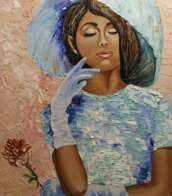 Shop Usova Lybov
Shop Usova Lybov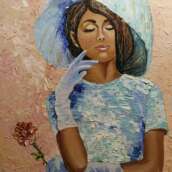

Lybov Usova
09.04.1955
Russia
Усова Любовь Ивановна. Живу в России, город Саратов. Живописью занимаюсь с 2013 года. Пишу маслом, сухой пастелью, мои работы есть в частных коллекциях. На заказ пишу пейзажи.

Artist shop
Usova Lybov
Russia
Number of products: 18


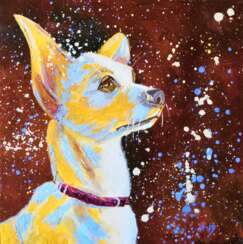

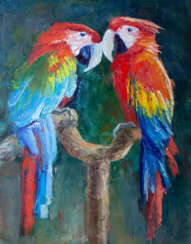





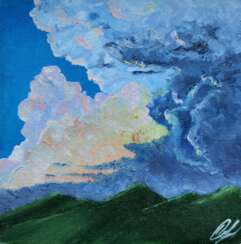

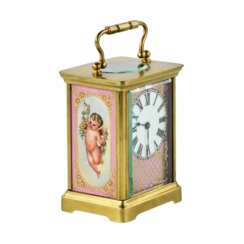


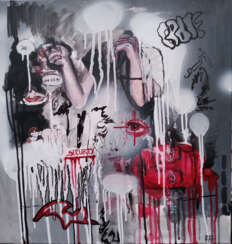

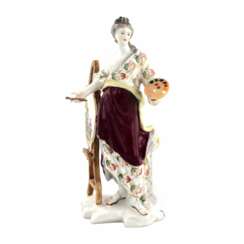




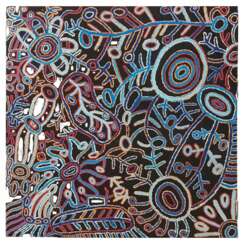





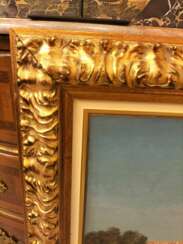



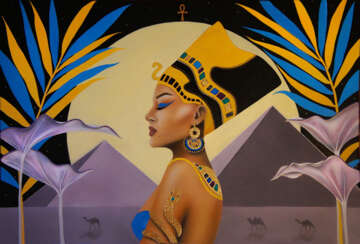






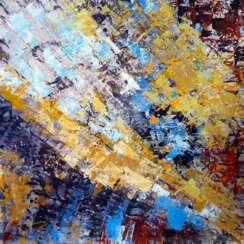

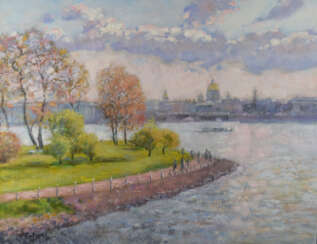

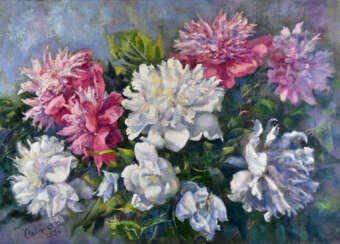

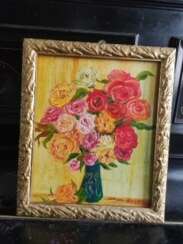

![You can't untoast the toast [ no.9]](/assets/image/picture_4116863/a0139/tmp334517230745595104696517230751933475jpeg__fix_374_244.jpeg)
![You can't untoast the toast [ no.9]](https://veryimportantlot.com/assets/image/picture_4116863/a0139/tmp334517230745595104696517230751933475jpeg__fix_374_244.jpeg)





